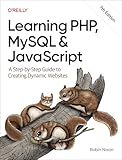Best PHP MySQL Guides to Buy in December 2025

PHP & MySQL: Server-side Web Development



Front-End Back-End Development with HTML, CSS, JavaScript, jQuery, PHP, and MySQL



PHP and MySQL: The Comprehensive Guide to Server-Side Web Development with PHP 8 – Build Dynamic Websites with Database Integration, Security, and More (Rheinwerk Computing)



Learning PHP, MySQL & JavaScript: A Step-by-Step Guide to Creating Dynamic Websites



Murach's PHP and MySQL (4th Edition) Professional Web Development Guide for Learning PHP & MySQL Database Programming - Beginner-Friendly Coding Book with MVC Pattern & Security Features



PHP, MySQL, & JavaScript All-In-One For Dummies



PHP, MySQL, & JavaScript All-in-One For Dummies (For Dummies (Computer/Tech))



PHP & MySQL in easy steps: Covers MySQL 8.0



Learning PHP, MySQL & JavaScript: A Step-by-Step Guide to Creating Dynamic Websites


To insert many rows into MySQL using PHP, you can follow these steps:
Firstly, establish a connection to your MySQL database using the mysqli extension in PHP. This can be achieved using the mysqli_connect() function.
Next, create an SQL query that includes multiple sets of values for insertion. For example:
$query = "INSERT INTO table_name (column1, column2) VALUES ('value1', 'value2'), ('value3', 'value4'), ('value5', 'value6')";
Note that "table_name" should be replaced with the actual table name where you want to insert the rows. "column1" and "column2" should be replaced with the actual column names in your table.
Then, execute the SQL query using the mysqli_query() function by passing the database connection and the query as parameters. For example:
$result = mysqli_query($connection, $query);
Ensure that $connection is the variable representing your database connection.
After executing the query, you can check if the insertion was successful by verifying the $result variable. If it returns true, the insertion was successful. If it returns false, there was an error.
Here's a complete example:
$connection = mysqli_connect('localhost', 'username', 'password', 'database_name');
$query = "INSERT INTO table_name (column1, column2) VALUES ('value1', 'value2'), ('value3', 'value4'), ('value5', 'value6')";
$result = mysqli_query($connection, $query);
if ($result) { echo "Rows inserted successfully."; } else { echo "Error inserting rows: " . mysqli_error($connection); }
mysqli_close($connection);
Remember to replace 'username', 'password', and 'database_name' with your actual MySQL credentials and desired database name.
This is a basic example to insert multiple rows into MySQL using PHP. You can modify it according to your specific requirements, such as inserting different column values or using dynamic data from variables.
What is the maximum number of rows I can insert into MySQL using PHP at once?
The maximum number of rows you can insert into MySQL using PHP at once depends on various factors such as the maximum packet size allowed by your MySQL server and the resources available on your server.
By default, the maximum packet size for MySQL server is set to 4 MB. This means that the total size of the data being inserted (including the query statement itself) should not exceed this limit. Therefore, the number of rows you can insert at once will vary based on the size of each row.
If you have control over the MySQL server configuration, you can increase the maximum packet size to allow larger data inserts. This can be done by modifying the max_allowed_packet configuration parameter in the MySQL server's configuration file (e.g., my.cnf or my.ini). However, keep in mind that increasing this value excessively may have performance implications and may also require additional server resources.
To insert a large number of rows, you can use techniques like batching or utilizing prepared statements to optimize the insert process and avoid memory limitations. This involves breaking down the insert into smaller chunks or using prepared statements with parameterized queries to efficiently insert multiple rows.
In general, it is recommended to perform benchmark tests to determine the optimal batch size for inserting rows in your specific environment to avoid any performance or resource limitations.
How to efficiently insert a large number of rows into MySQL using PHP?
To efficiently insert a large number of rows into MySQL using PHP, you can use the following methods:
- Use MySQL's multiple row syntax: Instead of making individual insert queries for each row, you can combine multiple rows into a single insert statement. This reduces the number of queries executed and improves performance.
$insertValues = []; foreach ($rows as $row) { $insertValues[] = "('" . implode("', '", $row) . "')"; } $insertQuery = "INSERT INTO table_name (column1, column2, column3) VALUES " . implode(',', $insertValues); mysqli_query($conn, $insertQuery);
- Use prepared statements: Prepared statements allow you to prepare the query once and execute it multiple times with different values. This reduces the overhead of query parsing and optimization.
$insertQuery = "INSERT INTO table_name (column1, column2, column3) VALUES (?, ?, ?)"; $insertStmt = mysqli_prepare($conn, $insertQuery); foreach ($rows as $row) { mysqli_stmt_bind_param($insertStmt, 'sss', $row[0], $row[1], $row[2]); mysqli_stmt_execute($insertStmt); }
- Use transactions: Transactions group multiple insert statements into a single unit of work, ensuring atomicity and improving performance.
mysqli_autocommit($conn, false); $insertQuery = "INSERT INTO table_name (column1, column2, column3) VALUES (?, ?, ?)"; $insertStmt = mysqli_prepare($conn, $insertQuery); foreach ($rows as $row) { mysqli_stmt_bind_param($insertStmt, 'sss', $row[0], $row[1], $row[2]); mysqli_stmt_execute($insertStmt); } mysqli_commit($conn); mysqli_autocommit($conn, true);
- Increase the PHP memory limit and script execution time: If you're inserting a very large number of rows, you may need to increase the PHP memory limit and script execution time to avoid memory errors or timeouts. You can do this by modifying the php.ini file or using the ini_set() function.
These methods help improve the efficiency of inserting a large number of rows into MySQL using PHP. Remember to optimize your table structure and indexes for better insert performance as well.
How to ensure data integrity while inserting multiple rows into MySQL using PHP?
To ensure data integrity while inserting multiple rows into MySQL using PHP, you can follow these steps:
- Validate Data: Before inserting the data into the database, validate it to ensure it meets the required criteria. This includes checking for empty fields, correct data types, length constraints, and any other validation rules specific to your application.
- Use Prepared Statements: Utilize prepared statements instead of directly inserting raw data into the SQL query. Prepared statements provide additional security by separating the SQL code from the data being inserted, preventing SQL injection attacks.
- Transaction: Enclose the insert statements within a transaction. This ensures that all the rows are inserted or none at all. If any error occurs during the insertion, you can roll back the entire transaction, maintaining the integrity of the data.
Here's an example of how to accomplish this in PHP:
// Assuming the $data array contains the rows to be inserted
// Initialize the database connection $mysqli = new mysqli("localhost", "username", "password", "database");
// Verify the connection if ($mysqli->connect_errno) { die("Connection failed: " . $mysqli->connect_error); }
try { // Start the transaction $mysqli->begin_transaction();
foreach ($data as $row) {
// Prepare the insert statement
$stmt = $mysqli->prepare("INSERT INTO tablename (column1, column2, ...) VALUES (?, ?, ...)");
// Bind the values to the statement
$stmt->bind\_param("ss...", $row\['value1'\], $row\['value2'\], ...);
// Execute the statement
$stmt->execute();
// Close the statement
$stmt->close();
}
// Commit the transaction if all insert statements were successful
$mysqli->commit();
// Close the database connection
$mysqli->close();
} catch (Exception $e) { // Rollback the transaction on any error $mysqli->rollback();
// Handle the error
echo "Error: " . $e->getMessage();
}
By following these steps, you can ensure data integrity while inserting multiple rows into MySQL using PHP.
What is the best way to insert multiple rows into MySQL using PHP?
The best way to insert multiple rows into MySQL using PHP is by using the "INSERT INTO" query with multiple value sets. Here's an example:
// MySQL connection parameters $servername = "localhost"; $username = "your_username"; $password = "your_password"; $dbname = "your_databasename";
// Create connection $conn = new mysqli($servername, $username, $password, $dbname);
// Check connection if ($conn->connect_error) { die("Connection failed: " . $conn->connect_error); }
// Array of values to be inserted $data = array( array('John', 'Doe', 'john@example.com'), array('Jane', 'Smith', 'jane@example.com'), array('Mike', 'Johnson', 'mike@example.com') );
// Prepare the query $query = "INSERT INTO your_tablename (first_name, last_name, email) VALUES";
foreach($data as $values) { $query .= " ('" . $values[0] . "', '" . $values[1] . "', '" . $values[2] . "'),"; }
$query = rtrim($query, ","); // Remove the last comma
// Execute the query if ($conn->query($query) === TRUE) { echo "Records inserted successfully."; } else { echo "Error: " . $query . "" . $conn->error; }
// Close the connection $conn->close();
In the example above, you need to replace "your_username", "your_password", "your_databasename", "your_tablename" with your actual database credentials and table details. The $data variable holds the array of values you want to insert.
By looping through the array and appending the value sets to the query, you form a single query that inserts multiple rows at once, which is more efficient than executing multiple individual insert queries.
How to insert rows with auto-incremented IDs into MySQL using PHP?
In order to insert rows with auto-incremented IDs into MySQL using PHP, you can follow these steps:
- Connect to the MySQL database using PHP. Use the mysqli extension or an object-oriented approach with the PDO class.
- Prepare the SQL query for the INSERT statement, including the table name and column names. Exclude the ID column from the query since it will be auto-incremented by the database.
- Execute the query using the appropriate method of your chosen database API (mysqli_query() or $pdo->exec()).
- If the query is successful, you can retrieve the auto-incremented ID value using the mysqli_insert_id() or $pdo->lastInsertId() functions. Store this value in a variable for reference later.
Here's an example using mysqli:
Remember to replace "localhost", "username", "password", "database", "your_table", "column1", and "column2" with your actual values.
Note: Using prepared statements with bound parameters is recommended to prevent SQL injection attacks.
How to use a loop to insert multiple rows into MySQL using PHP?
To insert multiple rows into MySQL using PHP, you can follow these steps:
- Establish a connection to the MySQL server by using the mysqli_connect() function. You must provide the host, username, password, and database name as parameters.
$conn = mysqli_connect("localhost", "username", "password", "database");
- Create an array of data containing the values of each row you want to insert. Each element of the array represents a row, and the values can be hardcoded or fetched from user input, files, or other sources.
$data = array( array("John", "Doe", "1990-01-01"), array("Jane", "Smith", "1992-05-10"), array("James", "Brown", "1988-09-15") );
- Use a loop, such as a foreach loop, to iterate through the array and perform the insert operation for each row.
foreach ($data as $row) { $firstName = $row[0]; $lastName = $row[1]; $birthDate = $row[2];
// Build the query
$query = "INSERT INTO users (first\_name, last\_name, birth\_date) VALUES ('$firstName', '$lastName', '$birthDate')";
// Execute the query
mysqli\_query($conn, $query);
}
- After looping through all the rows, close the database connection using the mysqli_close() function.
mysqli_close($conn);
Note: This example assumes you have a table named users with columns first_name, last_name, and birth_date in your MySQL database. Make sure to replace the table name and column names according to your specific database structure. Also, it's essential to properly sanitize and validate user input to prevent SQL injection attacks.
What is the best way to sanitize data before inserting multiple rows into MySQL using PHP?
The best way to sanitize data before inserting multiple rows into MySQL using PHP is by using prepared statements with parameterized queries. Prepared statements separate SQL code from data, eliminating the possibility of SQL injection and providing better performance.
Here's an example of how to sanitize data using prepared statements in PHP for multiple row insertion:
- Establish a database connection:
$servername = "localhost"; $username = "your_username"; $password = "your_password"; $dbname = "your_database";
$conn = new mysqli($servername, $username, $password, $dbname); if ($conn->connect_error) { die("Connection failed: " . $conn->connect_error); }
- Prepare the statement:
$stmt = $conn->prepare("INSERT INTO your_table (column1, column2, ...) VALUES (?, ?, ...)");
- Bind parameters and values:
$stmt->bind_param("ss...", $value1, $value2, ...);
The "ss..." represents the data types of the columns. For example, if column1 and column2 are of type 'string', you would use "ss". Replace the ellipsis (...) with the appropriate data types for your columns.
- Sanitize and set values:
$value1 = mysqli_real_escape_string($conn, $data1); $value2 = mysqli_real_escape_string($conn, $data2); // Repeat for each value
mysqli_real_escape_string() function is used here to sanitize the data, ensuring that any special characters in the data are properly escaped to prevent SQL injection.
- Execute the statement within a loop:
foreach($rows as $row) { $value1 = mysqli_real_escape_string($conn, $row['value1']); $value2 = mysqli_real_escape_string($conn, $row['value2']); // Repeat for each value $stmt->execute(); }
- Close the prepared statement and the database connection:
$stmt->close(); $conn->close();
By using prepared statements with parameterized queries and properly sanitizing the data, you can securely insert multiple rows into MySQL using PHP.
What is the role of transactions when inserting multiple rows into MySQL using PHP?
The role of transactions when inserting multiple rows into MySQL using PHP is to ensure data integrity and consistency.
In a transaction, multiple SQL statements are grouped together, and all statements must successfully run or none will be applied. This means that if any part of the transaction fails, such as an error during insertion or integrity constraint violation, the entire transaction is rolled back, and the database is left unchanged.
By using transactions, you can ensure that data is not inserted partially or with incorrect values. It also allows you to maintain consistency in related data, as changes made by one transaction are isolated from other transactions until they are committed.
Transactions help in preventing data corruption and maintaining data accuracy, especially when dealing with complex operations involving multiple rows or tables. They provide a mechanism for atomicity, where a set of statements is treated as a single unit of work, ensuring that data integrity is maintained throughout the process.
How to include dynamic data while inserting multiple rows into MySQL using PHP?
To include dynamic data while inserting multiple rows into MySQL using PHP, you can use prepared statements. Here's an example:
- Connect to the MySQL database:
$servername = "localhost"; $username = "your_username"; $password = "your_password"; $dbname = "your_database";
$conn = new mysqli($servername, $username, $password, $dbname); if ($conn->connect_error) { die("Connection failed: " . $conn->connect_error); }
- Prepare the SQL statement:
$stmt = $conn->prepare("INSERT INTO your_table (column1, column2) VALUES (?, ?)");
- Bind variables to the prepared statement:
$stmt->bind_param("ss", $value1, $value2);
- Loop through the dynamic data and execute the statement for each row:
$data = array( array("Value1-Row1", "Value2-Row1"), array("Value1-Row2", "Value2-Row2"), // Add more rows as needed );
foreach ($data as $row) { $value1 = $row[0]; $value2 = $row[1]; $stmt->execute(); }
- Close the statement and database connection:
$stmt->close(); $conn->close();
In this example, we are inserting two values (column1 and column2) for each row. The dynamic data is stored in an array called $data. You can modify the code according to your specific table structure and data.
